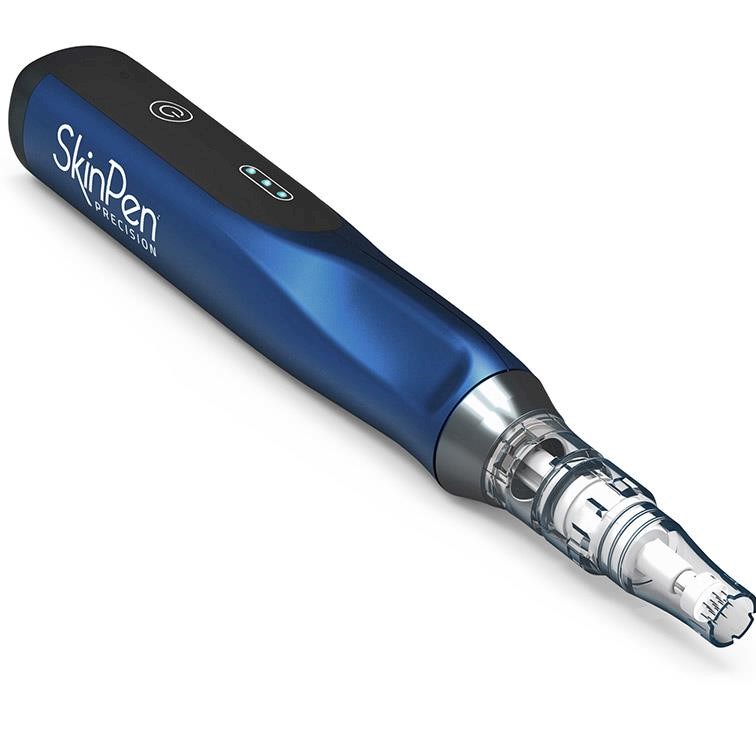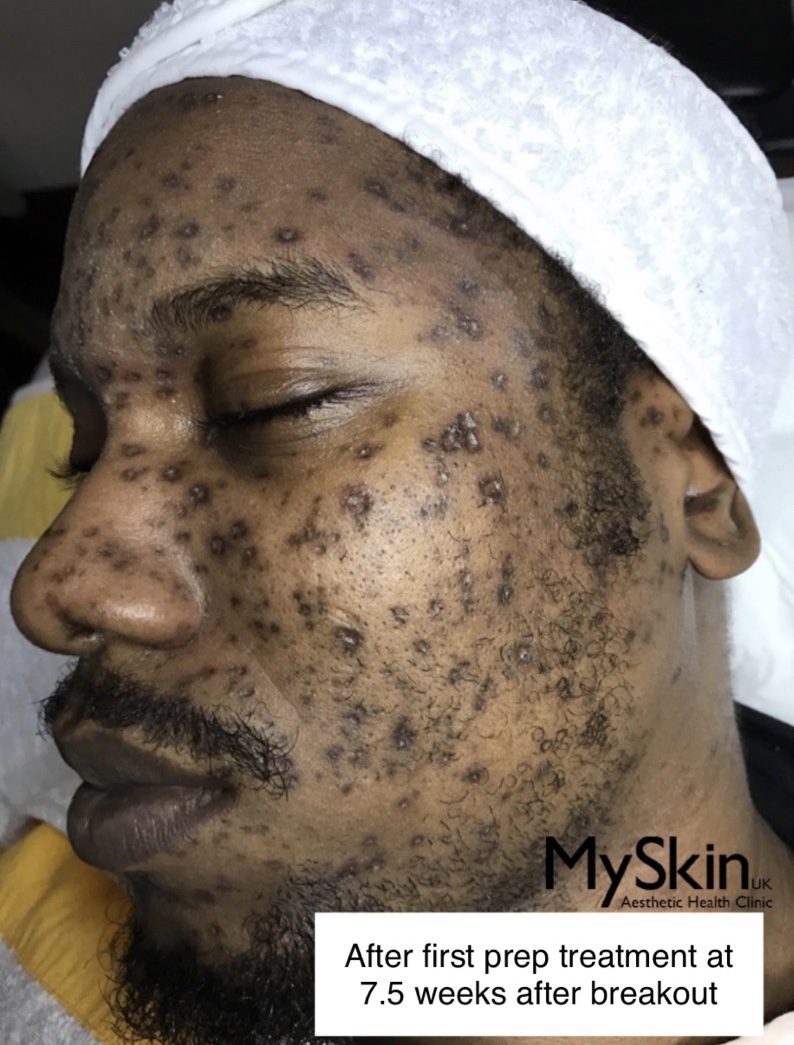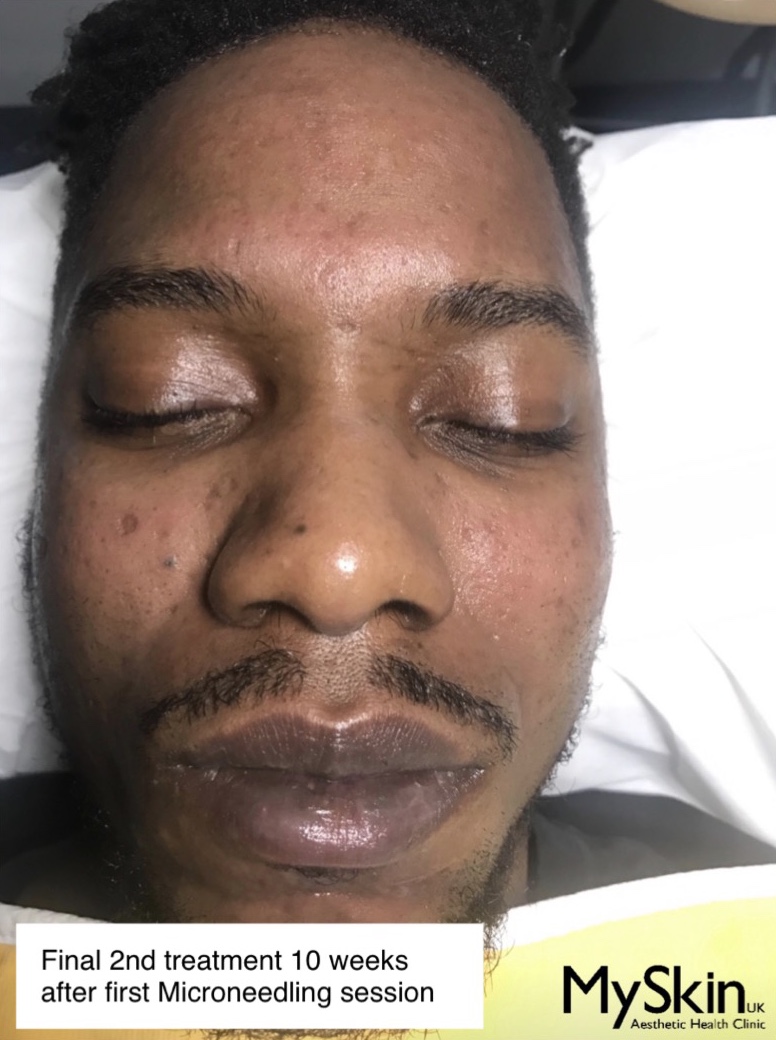AM Upskills: Using microneedling for severe skin damage

CONSULTATION
This patient came into clinic presenting with severe hyperpigmentation defects, scarring and dryness of the superficial epidermis after having contracted the varicella zoster virus in the form of chicken pox, likely caught from his four-year-old daughter and confirmed by a general practitioner.
The pox spread rapidly; the patient thought it was just an allergic reaction causing a few unsightly spots, but within hours the patient’s skin had become totally inflamed, with more spots growing faster and becoming larger, redder and more irritated by the minute.
The patient was a physically fit 33-year-old male with no psychological symptoms. He had a history of frequent migraines diagnosed at the age of 10. He had not undergone any procedures immediately before treatment, and no previous or recent operations. He was not using any professional pharmaceutical or medical aesthetic products. The patient had multiple chemical sensitivity (MCS) allergies to fragrances and household cleaning products.
He had washed his face very aggressively using Imperial Leather soap in a bid to keep the skin clean, but this turned out to be the beginning of his worst MCS reaction yet. The patient applied calamine lotion and took co-codamol to assist with a migraine that lasted for eight days. Although he wasn’t able to sleep for more than two hours during the reaction, the patient reported no pain or itching, contrary to usual chicken pox symptoms.
ASSESSMENT
It was clear that the ultimate treatment plan would consist of two things:
• consideration and compassion towards the patient’s psychological wellbeing
• controlled rejuvenation towards the physiological constraints applied with due diligence towards the health, safety and intricately-controlled wound management of post-inflammation and scar tissue.
This encompassed several details for consideration which would need to be addressed, such as:
• Hyperpigmentation defects from the range of trauma to the wounded cells right through to the proliferation of the body attempting to renew and build new skin cells
• The initial obvious dryness of the superficial epidermis due to physiological changes in epidermal water loss and the skin’s inability to adequately retain water within the keratin layers.
This meant that the skin appeared dull but most importantly, did not have the vital nourishment required to build a strong foundation for newly-formed and hydrated skin tissue.
CHOICE OF TREATMENT
SkinPen, distributed in the UK by BioActive Aesthetics, is always my preferred choice for skin rejuvenation. It is a precise and controlled method of wound management and skin-cell renewal, which permits little to no heat during the rejuvenation process, unlike chemical peels and lasers which deliver vast effects but do not adequately target the source of targeted cellular renewal so promptly. I have many case studies similar to this one from a range of skin types, colours and tones.
It took us three years to decide and acquire the device that we wanted to use for microneedling. It was an important decision as we knew from the start that skin education and patient trust were non-negotiable and imperative to our business.
We wanted to ensure that the quality of the microneedles were of the highest precision; there couldn’t be a risk of creating tears or rips in the delicate framework of collagen in the skin. We were impressed by the accurate oscillation of the inner motor of SkinPen Precision to produce fine, measured and precise insertions, which are important factors when applying controlled wound healing methods.
Plus, the ability to interchange needling depth within seconds depending upon the lesion or area that you are working on allows you to save time and concentrate your efforts more on providing treatment. The “lock out” feature is also fantastic; once a needle has already been loaded or used for a patient’s treatment, this safety feature does not enable you to reuse the needle again accidentally.


TREATMENT PLAN
Time was a factor; I knew that I had to prepare the skin prior to microneedling, which meant preparing the surface before the first treatment. This is not always necessary with microneedling, but to further facilitate the level of rejuvenation that I wanted to gain, I needed to “test” the hydrolipidic barrier to see if I could first provide exfoliation via gentle, low-level dermabrasion in order to remove surface dead skin; thereby inducing blood flow and oxygen stimulation around the cells. I also wanted to disturb the acid mantle by introducing simple and gentle products for the patient to use over the next few weeks until the next appointment.
Patient education was vital to this process. As part of an in-depth, 90-minute consultation addressing physical and mental health, it was necessary for the patient to understand the chemistry of the SkinPen process and the need for not only improving the initial condition of the skin, but the possible outcomes and any contra-actions towards ensuring that this would be a permanent, long-term improvement. Homecare would be gentle and uncomplicated and we provided all products and tools.
I selected simple products to help secure that the patient would stick to an uncomplicated, three-step routine in a bid to strengthen the skin’s barrier. Products consisted of MySkin UK Deep Cleansing Oil for free-radical protection and skin brightening, an AHA toning solution, NeoStrata Enlighten Pigment Controller Moisturiser and the daily application of NeoStrata Enlighten Skin Brightener with SPF40 to act as a skin protector and moisture facilitator, with inclusive tyrosinase inhibitors.
The patient was wary of applying SPF to his Fitzpatrick V skin as he did not like the white titanium and zinc casting of physical sunscreens. Enlighten Skin Brightener worked very well.
Although this was the best time to act – while the skin was now not in its active stage – I wasn’t concerned about rushing the microneedling process; I testify to having seen the benefits of SkinPen even on clients with years of deep scar tissue. The patient eventually received one medical microdermabrasion prep treatment and three SkinPen sessions spaced six weeks apart to also allow the skin to adjust to the prescribed homecare.
The patient is beyond delighted with his results. He reported back that the treatments have had a huge impact on his confidence and social life. It’s important to relate to patients that results vary – many people will see this patient’s “after” images and expect all skins to react the same. I like to maintain a realistic responsibility of expectation to all patients at the beginning of a fruitful consultation.

Sherine Vassel is owner and director of MySkin UK, an aesthetic skin clinic in London. MySkin offers advanced treatments including microneedling, chemical peels, machine-based facials and electrolysis. The clinic also has its own in-house product range. Vassel regularly lectures in beauty therapy and was involved in the development of the CPD Aesthetic Therapist programme, for which she was also course leader. Follow MySkin UK on Instagram: @ilovemyskinuk


